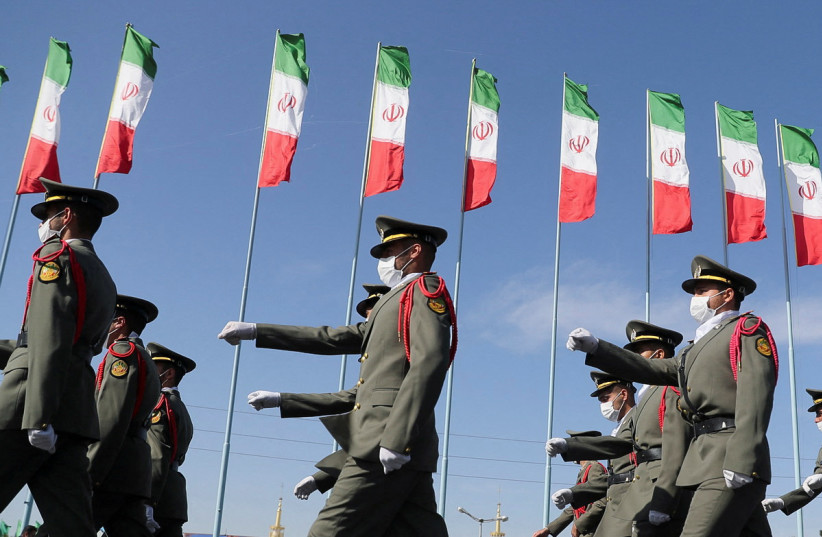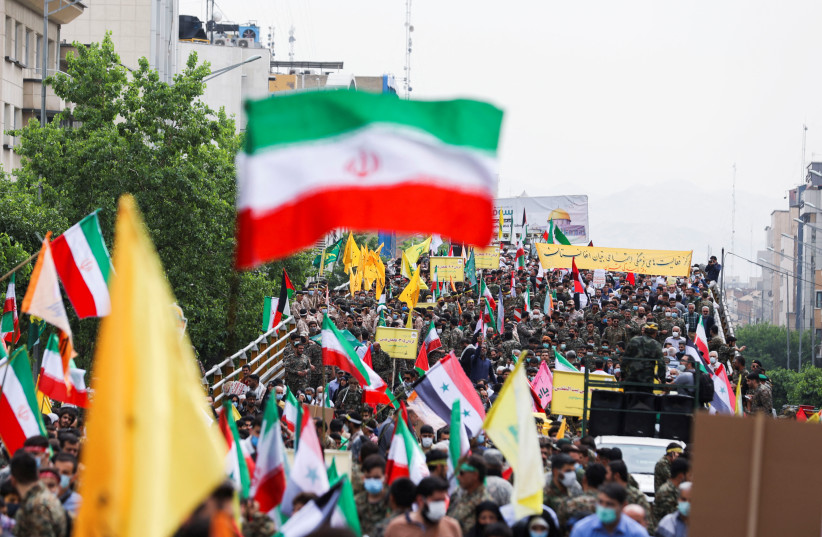In a recent lengthy interview, the deputy commander of the Iranian Army for Training Affairs Brig.-Gen. Alireza Sheikh discussed how Iran’s regime views its military doctrine.
The interview was published at Fars News, which is a pro-regime media outlet considered close to the IRGC. This is important because Iran is constantly focusing on training and conducting drills. In the last two weeks, for instance, the Islamic Republic has conducted two types of drills, one focusing on the IRGC navy, and another larger army exercise.
The recent interview reveals how Iran is following Russia’s military doctrine and also learning from Pakistan and how it is focusing on missiles and drones. Tehran is also warning its adversaries that it is practicing conducting raids that could destabilize the Gulf if Iran were confronted with a larger conflict.
How Iran understands its military role
It's important to understand that Iran’s military has several aspects. While it has traditional armed forces, such as a navy, air force and ground forces, it also has the IRGC forces. The IRGC acts as a paramilitary force, as elite forces guarding the regime, the force at the forefront of some of the missile and drone technology, and the force that conducts operations abroad in places like Iraq, Syria, Lebanon and Yemen. Therefore, the main reason it’s worth understanding the doctrine is to see how Iran understands its own military role.
The long interview is not exceptional – Iran’s pro-regime media is prone to having such interviews that appear to reveal a lot about its thinking and also include some introspection.
This makes Iran, as a regime, more interesting than many other authoritarian ones. It would be unlikely to have a similar long interview with a Russian military commander, a Chinese commander or a Turkish officer, where there was any introspection, beyond simplistic nationalist propaganda. Iran’s regime is a bit different.

Let’s take a look at what the commander said. First of all, the interviewer begins by noting the large extent of recent military drills, which were supposedly conducted over millions of square kilometers. This is a reference to the fact it included a large area of the coastline and also areas of the Gulf of Oman and the Indian Ocean.
It is a bit of an exaggeration for Iran to pretend it can really project its power over all this area at the same time, but nevertheless, it is trying to use drones and long-range missiles to cover immense areas of the Indian Ocean and also coastal areas. Tehran has shown it can strike at ships in the Gulf of Oman using drones, for instance.
The commander says the recent training was important to show that Iran’s education and training of recruits is paying off, adding that it helps hone tactics and strategy. Sheikh then moves on to discuss the future of warfare in the region. He says wars are not “single force” but rather include combined arms and joint forces, and will involve all the “resources of the nation.”
He discusses the importance of air defense and combining various units into combined operations. This means that Iran wants to be able to use its relatively small navy alongside its ground forces, air force and apparently the IRGC as well.
This kind of combined arms approach is not unique to Iran. Israel’s recent Momentum five-year plan has also focused on streamlining how units work together. The US Marine Corps does the same thing. In fact, the whole notion of modern warfare is about how to make different units work better together.
How will Iran defend itself from a maritime attack?
Next, the commander discusses Iran’s approach to defending its territory from any kind of attack that would be carried out from the sea. Clearly, the Islamic Republic doesn’t believe it would be invaded from Iraq since Iran has worked for the last decade and a half to hollow out and control its much smaller Western neighbor.
Iran doesn’t think there will be a war in its north, along the Azerbaijan-Armenia border, but appears to fear tensions with the Gulf the most. This means it must be afraid that the US or other countries could threaten it from the sea. The commander says the current doctrine of defense is to practice for an “offensive” into a country in the region. He says that any country hoping to reach Iran will have to cross a “sea of blood.”
“The defense policy is that no enemy should reach our soil,” he said, calling this “decisive defense.”
He then describes how Iran practices for an amphibious assault, apparently across the Persian Gulf or Gulf of Oman, using the navy, ground forces and airborne troops. He says Iran would first “infiltrate” into another country before conducting this raid to achieve a “bridgehead.”
This is wishful thinking, however. Iran’s small navy can’t conduct major operations like this. The US Navy in the Gulf and other partner forces would easily defeat an Iranian operation of any size. It’s unclear why Iran thinks this kind of amphibious operation would work and be anything more than a bizarre replay of something like the failed Dieppe raid conducted by the Allies in 1942 to test the feasibility of such an operation. Whereas the Allies failed and learned, the Iranians have yet to fail, but they would in such a scenario.
Has Iran become a regional drone and missile power?
Sheikh moves on from discussing the doctrine of an offensive defense to discussing how Iran has become a regional drone and missile power. In this assessment, he is discussing things that Iran has actually succeeded at. Tehran has exported drones to Russia, although he doesn’t mention this. He discusses how Iran used drones in recent drills and also how it used them to target a mock-up of a ship. He mentions the Karar drone as one of those used.
The interviewer at Fars News also asks the commander about their recent Zolfikar drill in which they created a mock-up of an Israeli Sa’ar 6 ship. The interviewer asks specifically about the “replica of the Zionist ship.” The commander doesn’t discuss Israel but notes that two drones were used in the drill to attack the ship and a mock-up building and that this shows the precision of Iran’s drones.
Next, the Iranian discusses the air defense operations of the regime.
He notes that the country has successfully created a complex multi-layered air defense system, including defenses like the 3rd Khordad system. Iran used that system to down a US Global Hawk drone in 2019. While the Iranian commander acknowledges some “problems” during the recent drills and the critique of the drills for being very costly (when Iran is facing sanctions), he nevertheless justifies them and says the air defenses performed well. Clearly, Iran is trying to integrate its radar and detection systems alongside the air defenses. It knows that in 2020, it mistakenly shot down a Ukrainian civilian airliner over Tehran.
This was because Iran’s air defenses were on alert for US airstrikes and mistook the civilian plane for such a strike or one using a cruise missile. Iranian air defenders also made a mistake by not alerting civilian planes and redirecting them. This led to mass murder by the Iranian regime by downing the airliner. Clearly, the regime wants to learn from this mistake but won’t admit it.
Iranian general says Islamic Republic attempting to create better air defenses
The brigadier-general then makes several interesting claims regarding the country's ground forces. He notes that in contrast to Iran’s innovations with drones and its attempts to create better air defenses and a combined operations amphibious force, Iran’s ground forces are basically stuck in the “classical” past. He admits that this “classical” war hasn’t changed since waging a massive conventional war with Iraq, although it had to sacrifice heavily in the war because Iraq had better weapons. T
The commander hints at the reality, which is that Iran’s ground forces may be large on paper but are not really prepared for a modern war.
While they “shake the ground,” the reality is that Iran is trying to learn from other countries. He claims some Iranians study ground operations in Pakistan and that he recently visited Russia. This is a revelation that points to Iran wanting to learn from Russia’s war in Ukraine. The commander says he visited Russian military training school counterparts.
He also references the war on ISIS and how Iran helped regional countries, such as Iraq, fight the jihadist group.
Discussing Iran’s air force, he notes that Iran is still flying older model helicopters and planes. In fact, Iran’s air force is an antique that dates from the era of the Shah and it has not been able to upgrade its planes and helicopters much since. The commander says that Iran makes up for this by having missiles that have a stand-off capability, meaning they can be fired from a distance of some “one hundred kilometers.” Iran’s air force in this respect is of negligible importance.

“Enemies know our power…and they monitor us. We also show a part of our ability to them… The enemy knows that he should not make mistakes in their calculations and should not make the same mistakes they have made in other places regarding Iran. Iran is not like any other country.”
Alireza Sheikh
Admitting Iran's limitations and problems
The commander acknowledges some limitations and problems throughout the interview, although he doesn’t go into a lot of specifics. Clearly, it can be understood that Iran knows its limitations in its conventional armed forces. He says that while the drills are important for learning to combine Iran’s various units together in the field, they have a second message which is to show Iran’s enemies that it is serious.
“Enemies know our power…and they monitor us. We also show a part of our ability to them… The enemy knows that he should not make mistakes in their calculations and should not make the same mistakes they have made in other places regarding Iran. Iran is not like any other country.”
The long, wide-ranging interview reveals that Iran is aware of its challenges on the modern battlefield and it also shows how the Islamic Republic is increasingly relying on missiles and drones.
It also shows that Iran has a message to the region. It wants its adversaries to know that any conflict with Iran would be a tough one and that Tehran would quickly move to destabilize the Gulf and launch raids and attacks.
